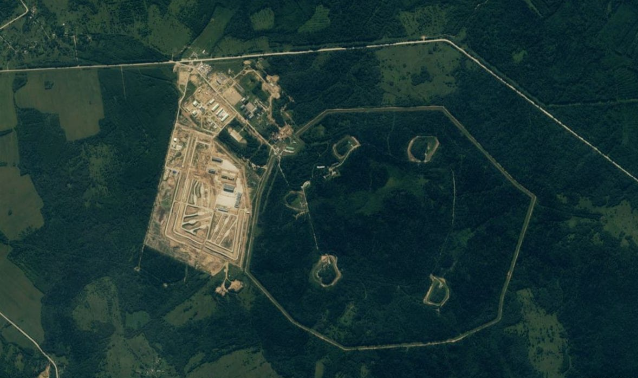Recent reports indicate that U.S. researchers have identified a likely deployment site in Russia for the 9M370 Burevestnik, a nuclear-powered cruise missile claimed by President Vladimir Putin to be “invincible.” The missile, known as SSC-X-9 Skyfall to NATO, is said to possess near-limitless range and evade U.S. missile defenses. However, some experts question its strategic benefits and safety.

Using satellite images from July 26 provided by Planet Labs, analysts have pinpointed a construction site near a nuclear warhead storage facility, known as Vologda-20 or Chebsara. This site, located approximately 295 miles north of Moscow, is suspected to be where Russia is preparing to deploy the Burevestnik missile.
Decker Eveleth, an analyst at CNA, discovered what appear to be nine horizontal launch pads under construction, divided into three groups and protected by high berms. These pads are connected by roads to service buildings and existing nuclear storage bunkers.
The Russian defense ministry and U.S. intelligence agencies have not commented on the findings or the Burevestnik’s strategic significance. The Kremlin has deferred questions to the defense ministry, while U.S. agencies have declined to provide further details.
Eveleth and Jeffery Lewis from the Middlebury Institute have reviewed the imagery and confirmed the uniqueness of the site. Lewis noted that the construction aligns with Russia’s development of this new missile system.
Hans Kristensen from the Federation of American Scientists has also reviewed the images and suggested they might be related to the Burevestnik, though he could not make a definitive assessment due to Russia’s typical separation of missile launch sites from nuclear storage.
The Burevestnik’s deployment could enable Russia to stockpile missiles in a manner that allows rapid launch, according to Eveleth and Lewis. This deployment might offer tactical advantages but also risks significant safety issues.
Sergei Ryabkov, Russia’s Deputy Foreign Minister, has stated that Russia will adjust its nuclear policy in response to perceived Western escalations in Ukraine. This adds to the ongoing tension surrounding the Burevestnik’s development.
The Burevestnik has a troubling test history, with at least 13 tests since 2016, only two of which were partially successful. Problems include a 2019 explosion during a botched recovery of an unshielded reactor, raising safety concerns.
Experts such as Cheryl Rofer and Thomas Countryman criticize the Burevestnik as a “flying Chernobyl,” arguing that its design poses a greater threat to Russia than to other countries due to potential radiation hazards.
Although the missile’s deployment is not restricted by the New START treaty, which limits strategic nuclear weapons, there is no current push from Washington to negotiate limits on the Burevestnik. The looming expiration of New START in 2026 and ongoing conflict in Ukraine contribute to the strained nuclear diplomacy between the U.S. and Russia.
Pavel Podvig and other experts suggest that the Burevestnik might be used as a political tool by Putin, reinforcing his strongman image and signaling to Washington that Russia’s concerns about U.S. missile defenses cannot be ignored.

